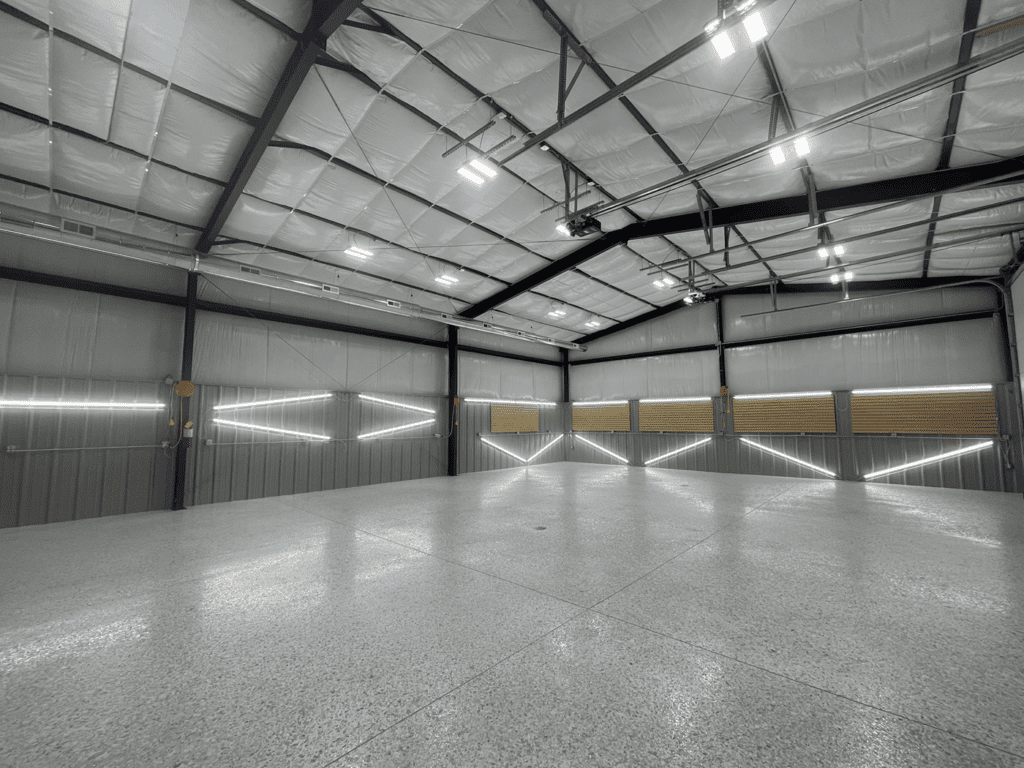Epoxy vs. Polyaspartic Pricing
Epoxy - $4.99/sq. ft.
Polyaspartic - $5.49 sq. ft.
- Slower Curing Time
- Poor longevity
- Long Installation Process
- UV Light Vulnerability
- Fast Cure Time
- UV Resistant
- Very Durable
- Temperature Flexibility
Why Choose Polyaspartic?
When comparing the initial costs of polyaspartic coatings to traditional epoxy, one might notice that polyaspartic is marginally more expensive at just $5.49 per square foot, a slight increase over epoxy’s $4.99 per square foot. However, this minor difference in upfront cost is vastly outweighed by the long-term benefits and savings that polyaspartic offers. The durability and resilience of polyaspartic coatings mean fewer repairs and replacements over time, ultimately saving thousands of dollars in maintenance for your concrete surfaces. Its advanced formula provides a formidable shield against stains, chemicals, UV fading, and physical impacts, ensuring your investment remains protected for decades.
Moreover, the value of polyaspartic extends beyond mere cost savings. The rapid cure time of polyaspartic coatings allows for same-day installation and usage, minimizing downtime in busy environments. Unlike epoxy, which is prone to yellowing and can become dangerously slippery when wet, polyaspartic maintains its color clarity and safety under various conditions, including direct sunlight and high moisture areas. The flexibility and customizability of polyaspartic finishes also enable a tailored look without compromising on performance, offering an aesthetically pleasing and functional surface. In essence, while polyaspartic may initially seem slightly more expensive than epoxy, its superior qualities and longevity make it a worthwhile investment for those seeking a high-quality, durable, and low-maintenance flooring solution.

Residential & Commercial Flooring
- Garages
- Basements
- Warehouses
- Labs
- Schools
- Churches
- Kitchens
- Offices










FAQS
Yes, you can find flexible payment terms and a 60-second credit application on our financing page here.
https://www.rocketcityepoxy.com/financing
Polyaspartic and epoxy flooring have their strengths and are used for various purposes, depending on the specific environment’s needs.
Here’s a quick comparison between the two:
Durability: Both polyaspartic and epoxy are extremely durable and resistant to heavy traffic. However, polyaspartic is generally considered more flexible, making it more resistant to impacts and less likely to chip or crack.
Cure Time: Polyaspartic floors have a much faster cure time than epoxy. While an epoxy floor might take several days to cure, a polyaspartic floor can often be applied and fixed in a single day.
Temperature Sensitivity: Polyaspartic coatings can be applied at a broader range of temperatures than epoxy. This is especially beneficial for environments with significant temperature fluctuations.
UV Stability: Polyaspartic coatings are more resistant to yellowing from UV exposure, which can be a common problem with epoxy coatings over time.
Resistance: Polyaspartic is more resistant to chemicals, oil, and other substances that might stain or damage the floor. Epoxy is also resistant to these substances, but polyaspartic is generally considered superior.
Cost: Polyaspartic is typically more expensive than epoxy due to its superior performance and quick curing time.
Polyaspartic floor coatings distinguish themselves from epoxy coatings through a variety of advantageous properties, contributing to their extended lifespan. Here are several pivotal factors:
- Enhanced Durability: Boasting exceptional resistance to impacts, abrasions, and general wear, polyaspartic coatings outperform epoxy in durability, ensuring a longer lifespan for your flooring.
- Superior Chemical Resistance: With an elevated resistance to chemicals, polyaspartic coatings are less susceptible to damage from oil, gasoline, salts, and other aggressive substances that typically compromise epoxy coatings over time.
- Adaptability to Temperature Variations: Polyaspartic coatings maintain their integrity across a broader temperature spectrum, reducing the risk of cracking or peeling in extreme weather. Epoxy coatings, conversely, are prone to brittleness and cracking in severe cold or heat.
- UV Stability: Unlike epoxy, which can yellow and dull when exposed to sunlight, polyaspartic coatings are resistant to UV radiation, preserving their color and sheen over time.
- Quicker Curing Process: The ability of polyaspartic coatings to cure rapidly, within a matter of hours, minimizes the risk of contamination during the curing phase, leading to a more robust and enduring finish.
While polyaspartic coatings offer these significant advantages, it’s important to consider that they may come with a higher price tag and require more precision during application than epoxy coatings. Furthermore, the durability and lifespan of any floor coating, whether polyaspartic or epoxy, greatly depend on thorough surface preparation, meticulous application techniques, and consistent maintenance practices.
Epoxy flooring is renowned for its ability to achieve a high-gloss finish, thereby enhancing the reflectivity of the floor surface. It offers a virtually limitless array of colors and designs, from decorative flakes and aggregates to striking metallic or marble effects. Additionally, epoxy flooring can be customized with unique designs and logos, making it an attractive choice for commercial or public spaces. Despite these benefits, one drawback of epoxy is its susceptibility to yellowing or fading when exposed to UV light, which can detract from its aesthetic appeal over time.
In comparison, polyaspartic flooring boasts a similarly broad selection of colors and styles, with the added advantage of UV resistance, preventing yellowing or fading under sunlight. This type of flooring also offers a uniform gloss finish, potentially offering greater visual appeal in certain environments. Furthermore, polyaspartic floors are notably resistant to scratches and general wear, contributing to their long-lasting appearance.
Choosing between polyaspartic and epoxy flooring involves more than just aesthetic considerations; factors such as the floor’s intended purpose, budget constraints, the feasible downtime for installation, and anticipated maintenance requirements also play crucial roles in the decision-making process.
Polyaspartic floor coatings stand out for their rapid curing rates relative to other flooring solutions, like epoxy or urethane-based coatings. The exact curing duration can fluctuate based on the specific formulation used, environmental conditions at the time of application, including temperature and humidity, as well as the application’s thickness.
Typically, a polyaspartic coating is set to handle light foot traffic within a mere 2 to 4 hours following its application, achieving full cure status in about 24 hours.
Polyaspartic flooring boasts exceptional durability and resistance, making it an ideal choice for both high-traffic commercial and industrial environments, as well as residential garages. Its resilience and easy maintenance are key benefits. Here’s a comprehensive guide on how to keep your polyaspartic floors clean and in prime condition:
Sweeping or Vacuuming:
- Regularly sweeping or vacuuming is crucial to remove dust, dirt, and debris. This step helps in preventing the accumulation of grime and maintains the aesthetic appeal of your flooring. Opt for a soft-bristled broom or a vacuum cleaner without a beater bar to avoid scratching the floor’s surface.
Mopping:
- Follow up the sweeping or vacuuming with mopping for a more thorough cleaning. Utilize a microfiber mop along with a gentle, pH-neutral floor cleaner to avoid potentially damaging the coating. Steer clear of harsh chemicals that could deteriorate the floor’s finish over time.
Spot Cleaning:
- For specific areas that need extra attention due to stubborn stains or spills, spot cleaning is effective. Promptly addressing spills will prevent them from becoming permanent. Use a suitable degreaser for oil or grease marks, adhering to the manufacturer’s recommendations for any cleaning product you apply.
Drying the Floor:
- After mopping or dealing with spills, make sure the floor is completely dry to eliminate any risk of slipping. You can either use a dry mop, towels, or simply let the floor air dry, depending on your preference and the specific situation.
Periodic Deep Cleaning:
- The frequency of deep cleaning depends on the level of foot traffic your flooring endures. For a deep clean, employ a floor scrubber equipped with a soft brush attachment paired with a mild cleaning solution. After scrubbing, it’s important to rinse the floor with clean water and then dry it thoroughly to ensure no residue is left behind.
Adhering to this cleaning regimen will help maintain the integrity and appearance of your polyaspartic flooring, ensuring it continues to perform well and look great for years to come.
